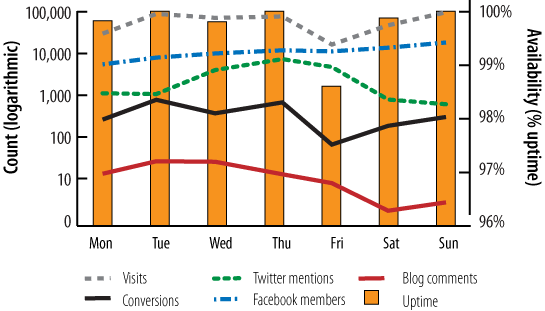One of the most difficult types of data integration involves linking what happens elsewhere in the world to your web analytics data. Whether it’s a poster on a bus that contains your URL, a mention on a social network, or a call to your sales department that began on your website, it’s hard to monitor the long funnel.
There are two main ways of tying offsite activity back to your website. The first is to gather information from social network sites where visitors opt in and share their identities. The second is to mark your offsite messages with custom URIs that you can track with your analytics tool.
The first approach, which is the basis for systems like Open Social, Beacon, OpenID, myBlogLog, and Disqus, requires that you enroll yourself in the social network somehow. Then visitors who want to share their identity with you can do so.
This is the simplest way to track users. You may even be able to analyze inbound links from certain social networks to see who’s sending traffic. For example, referrals from www.twitter.com/acroll indicate that the visit came from the profile page of Twitter user “acroll.” In practice, traffic of this kind is only a fraction of Twitter traffic, as most people view links in their own Twitter feeds and with third-party desktop clients like Tweetdeck and Twhirl.
Many social networks want to monetize the analysis of their traffic; indeed, “selling analytics” is the new “ad-driven” business model. It’s therefore unlikely that you’ll get visitor analytics for free at the individual visitor level unless you ask visitors to log in. But don’t write this possibility off: in many situations, your market will gladly tell you who it is. Musicians, for example, have legions of fans who crave the attention and acclaim of the artists they support, and may be willing to divulge their identities in return for access to a celebrity or early notification about tickets or appearances. There are often ways you can encourage visitors to self-identify if you're creative.
Any data analysis requires a key of some kind. The more specific that key, the more closely you’ll be able to tie together the data. All interactions have some basic attributes: where they happened, when they happened, any keywords that were mentioned, and in some cases, the person who said it.
The easiest way to compare two sets of data, then, is by time. Lining up graphs of mentions on Twitter, Facebook friends, web traffic, and so on, is an easy way to see which factors are related (Figure 17-8).
Figure 17-8. The most basic way to consolidate data manually is to display multiple data sources in a spreadsheet using time as a common key
If keys like date or geography aren’t enough to consolidate your information—particularly if you want to link individual actions to individual outcomes, rather than just comparing aggregate data over time—you’ll need to make your own keys. These may be a unique URL on printed materials, a URI parameter hidden in a shortened URL, a unique phone number for each visitor to call, or some other way of linking together the many offsite interactions your visitors have with you.
In the end, you’ll have to take whatever data you can get, assemble it according to common keys like time or geography, and track it over time to determine how your many sources of web monitoring information are related.

